Individuals with Disabilities Education Act (IDEA)
- In 2012-2013, 13% of public school students received a specialized education program, as reported by the U.S. Department of Education, National Center for Education Statistics (Woodworth, 2016)
- Key principles of the IDEA: freedom of discrimination, safe environment creation, and an interdisciplinary team approach.
The Individuals with Disabilities Education Act (IDEA) was introduced by the US as a special federal law to ensure that schools can meet the needs of students with disabilities (Wilmshurst & Brue, 2018). Every state is required to adopt policies to implement the IDEA, and parents are also to be engaged in the process of discussing a child’s learning disability (LD) and needs (Kauffman, Hallahan, Pullen, & Badar, 2018). The key principles of the IDEA are freedom of discrimination, safe environment creation, and an interdisciplinary team approach.
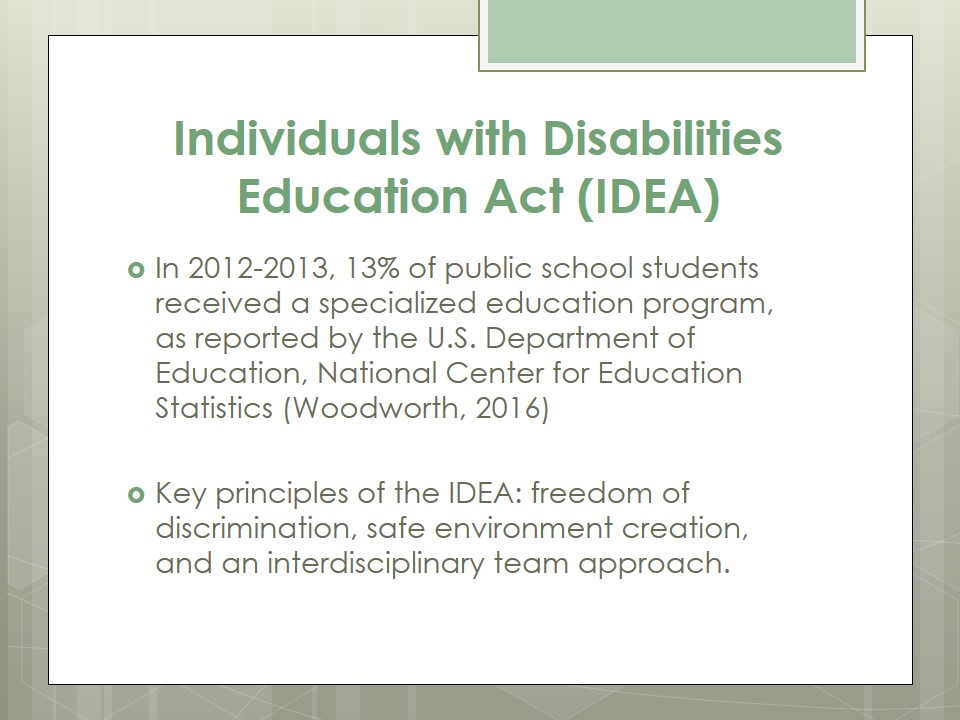
IDEA: Eligible Categories
- Specific learning disability (SLD) (Dyslexia, dysgraphia, dyscalculia);
- Other health impairment (ADHD);
- Autism spectrum disorder (ASD);
- Emotional disturbance (depressionand anxiety);
- Speech or language impairment;
- Visual impairment, including blindness;
- Deafness;
- Hearing impairment;
- Deaf-blindness;
- Orthopedic impairment;
- Intellectual disability;
- Traumatic brain injury;
- Multiple disabilities (Kauffman et al., 2018).
According to this act, the least restrictive environment should be created to provide a free appropriate public education (FAPE) for eligible children who are aged between 6 and 17 years. The disabilities that are included in the IDEA are presented on the slide. In particular, the mentioned list contains autism, attention deficit hyperactivity disorder (ADHD), emotional disturbance, visual impairment, intellectual disability, et cetera (Kauffman et al., 2018).
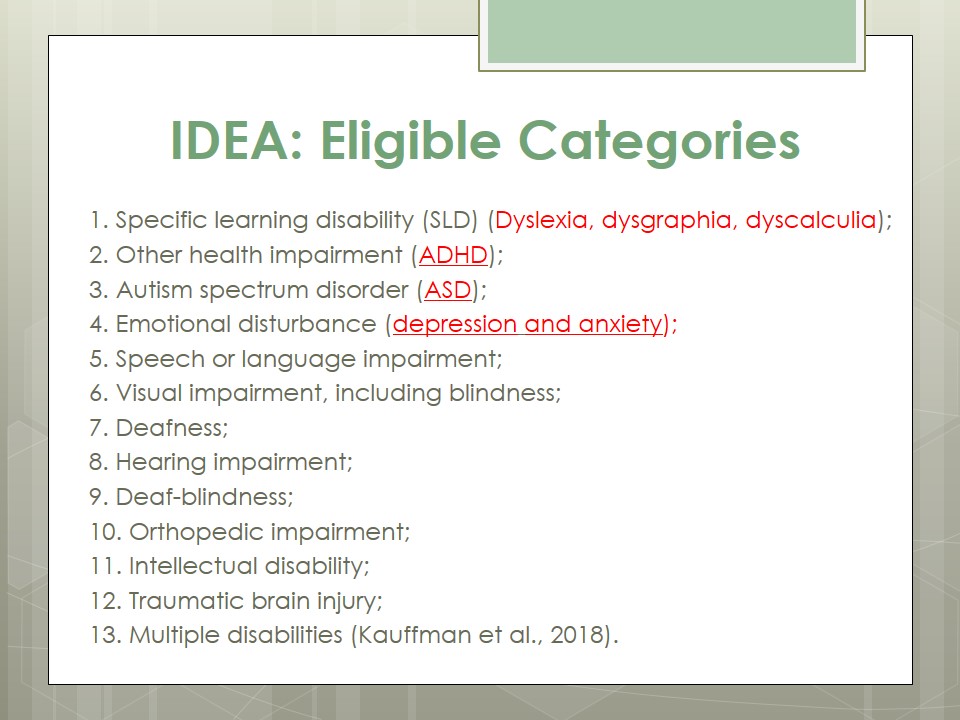
Individualized Education Programs (IEPs)
- An individual plan of learning in consistence with a student’s needs and abilities;
- Includes annual progress measurements and a collaborative work of the stakeholders (Caruana, 2015).
The Individualized Education Program (IEP) aims at offering an individual plan of learning in consistence with a student’s needs and abilities. Among the eligibility criteria, having at least one of the disabilities from a special list and the need for specific instructions can be noted. If the disability affects a student’s academic performance to benefit from the general learning environment, he or she should be given specialized instruction (Caruana, 2015). The goals of the IEP include annual progress measurements and a collaborative work of the stakeholders, who are involved in this program, including parents, school psychologists, special education teachers, grade level teachers, and district representatives. For a 504 Plan, the rules about the team members are less formal since they only mention that people familiar with a student should be engaged.
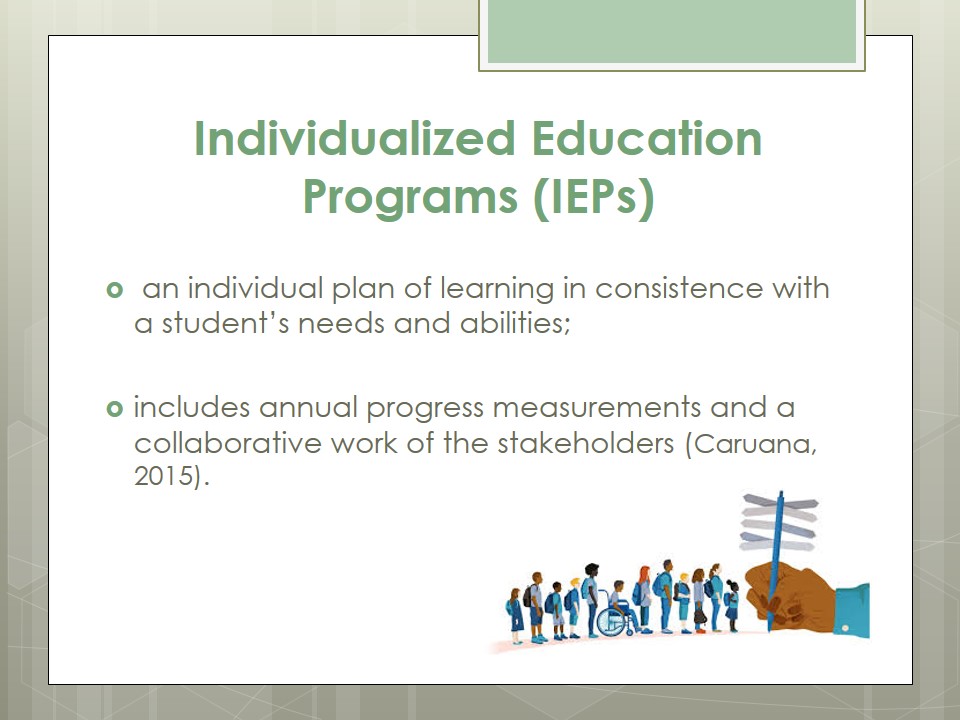
504 Plan
- According to the Rehabilitation Act of 1973, the schools should provide maximum adaptation to students with disabilities and their full participation in school life;
- The adjustments for ensuring major life activities of students should be made.
On the contrary to the IEP that refers to a SE law, the 504 Plan is attributed to federal civil rights, as it is stated by Section 504 of the Rehabilitation Act of 1973, which is to be applied in cases when a child needs extra support for emotional, physical, and psychological challenges (the list of disabilities is wider than for the IEP (Kauffman et al., 2018). The conditions that limit major life activities serve as the indicators that point to the importance of 504 plans. Such conditions can include breathing, speaking, caring for oneself, hearing, performing manual tasks, and so on.
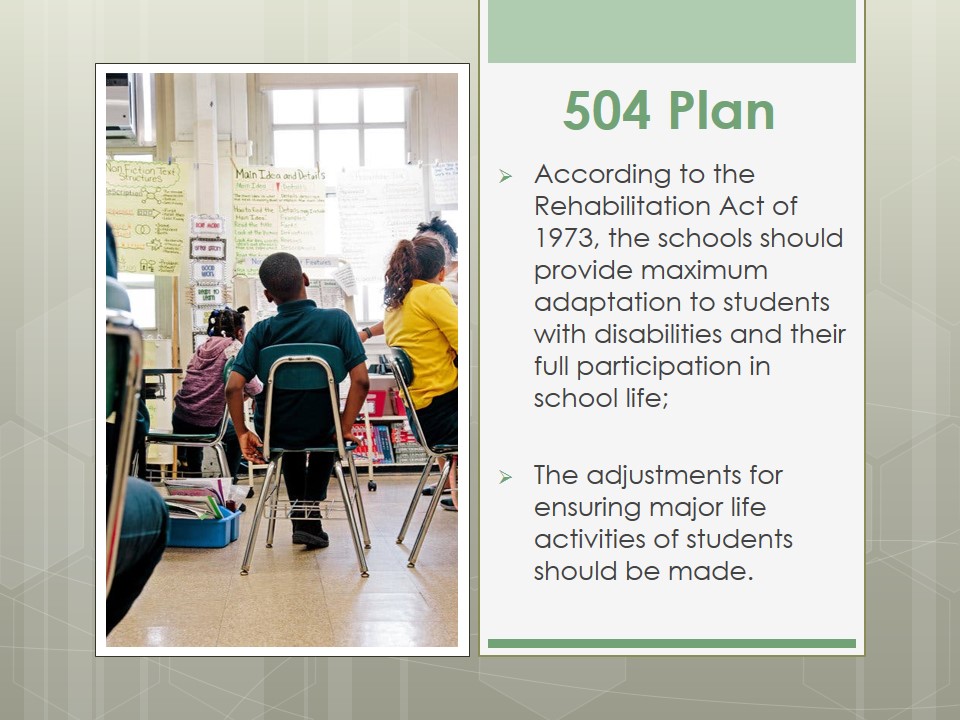
IEPs vs. 504 Plan
The details of the 504 Plan clarify any social, academic, and organizational adjustments in the educational environment, which are not covered by the IEP (Woodworth, 2016). As a rule, an informal document is completed, and a school takes the responsibility for accommodating one’s learning. Another difference between the identified plans lies in the review and revision: the IEP should be reconsidered at least once a year, but the regulations for the 504 Plan vary across the states. The disputes related to special education plans can be resolved in similar and different ways. For example, mediation and lawsuit are the two universal methods; due process complaint and resolution session are characteristic of the IEP; and impartial hearing along with a complaint to the office for civil rights (OCR) are more likely to be used in terms of the 504 Plan.
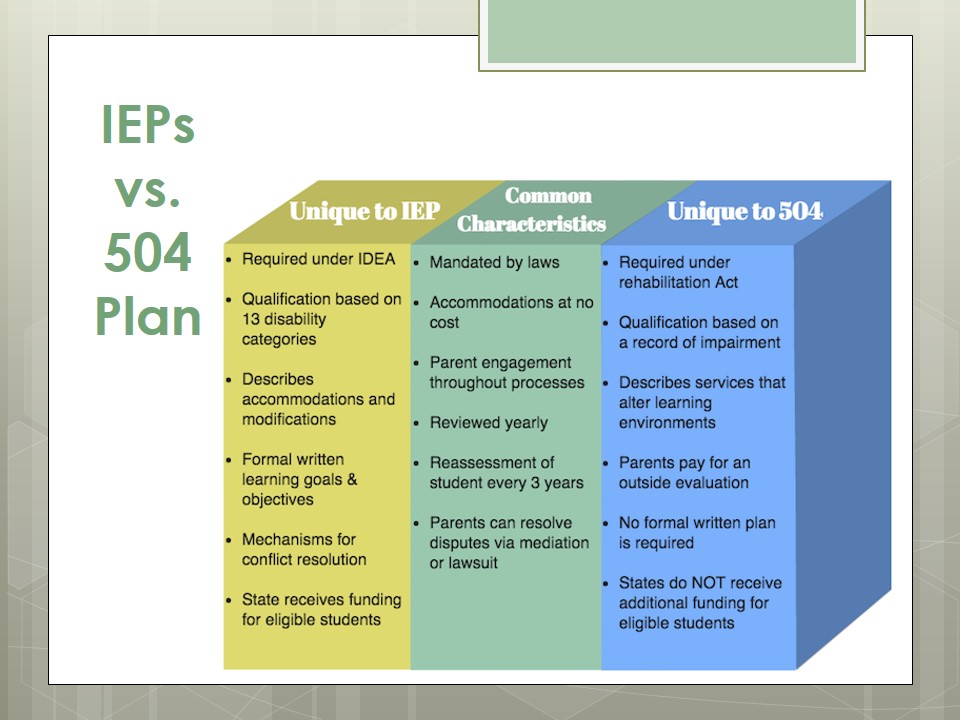
Individualized Family Service Plans (IFSPs)
- Helps in early intervention in children up to age 3.
- Hhe services and expected outcomes a toddler or baby should be provided with: the present level of development, functioning, and needs is assessed to how the family can act to best support their child (Wilmshurst & Brue, 2018).
Compared to the IEP and 504 Plan, an Individualized Family Service Plan (IFSP) helps in early intervention in children up to age 3. According to Wilmshurst and Brue (2018), it is both a process and document that is used to involve families in the provision of early intervention services. The resources, concerns, strengths, and weaknesses are considered while planning and personalizing the services (Woodworth, 2016). Likewise the IEP and 504 Plan, the IFSP can be revised of it required to meet the needs of a particular child.
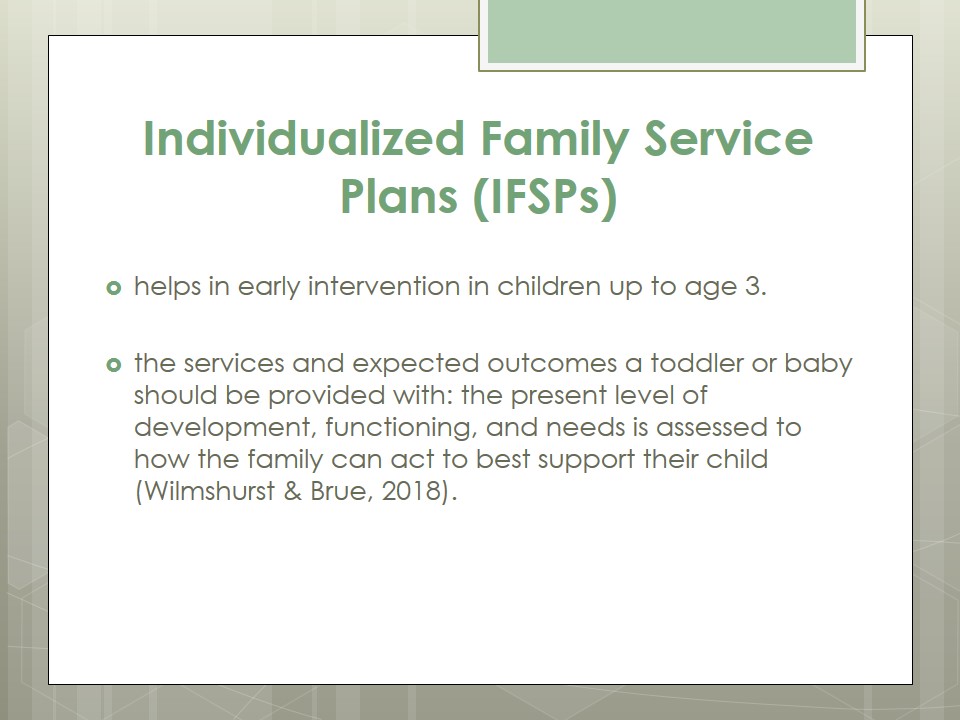
General Process for Special Education Identification
The general process for special education identification comprises several stages that are presented on the slide. The Child Find Mandate obliges schools to evaluate and serve children, and the issues that can trigger this are behavior struggles, lacking social skills, school refusal, and problems with emotional regulation. To meet this duty, the districts locate children aged 3-21 if they are suspected of having one or several disabilities. More information can be received from the Office of Superintendent of Public Instruction (OSPI) (Smeets & Roeleveld, 2016). School referral implies that school personnel notices some deviations, which can act as the basis for determining the eligibility for special education. A child’s parents can also make a request to schools, parent referral, for conducting their child’s assessment, which should be done in a written form. The consent should be obtained from parents prior to beginning the evaluation process as it confirms their awareness of the procedures being conducted.
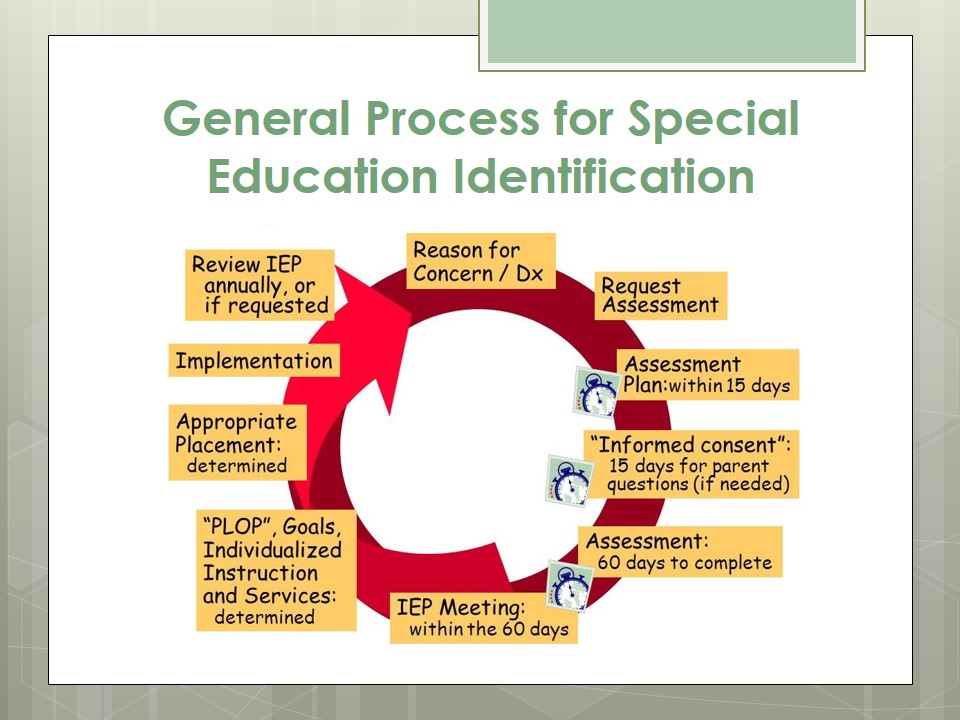
Roles of Stakeholders
- Parents should not underestimate their role in the team since they provide critical input, having the fullest understanding of a child’s psychological, physical, social, and developmental background.
- Therefore, the family should act as the best advocate for the child, monitoring the identification and service delivery (Smeets & Roeleveld, 2016).
School personnel should be attentive to children since emotional and psychological struggles are likely to significantly impact the way children with disabilities learn and interact with others (Hornby, 2015).
The family of a student with disability, who requires special attention, is a resource that can significantly facilitate the process of transition from GE to SE by explaining this process and answering the emerging questions. Parents should not underestimate their role in the team since they provide critical input, having the fullest understanding of a child’s psychological, physical, social, and developmental background. In sum, all of the mentioned stakeholders are essential to ensure proper support and meet the unique needs of a particular student.
Each of the stakeholders involved in the identification and implementation of special education programs plays an important role as a team member. In terms of school referral, a general education teacher, a special education teacher, or an administrator may ask for the evaluation if he or she notices alarming behaviors (Smeets & Roeleveld, 2016). Once a program was adopted for a student with disability, support and reporting should be provided by a special education teacher, who is responsible for giving the necessary information to a GE teacher, adapting the curriculum, establishing collaboration with other stakeholders, and completing the records. As for the district faculty, it plays a key role in identifying disability and reporting the suspicions to the schools.
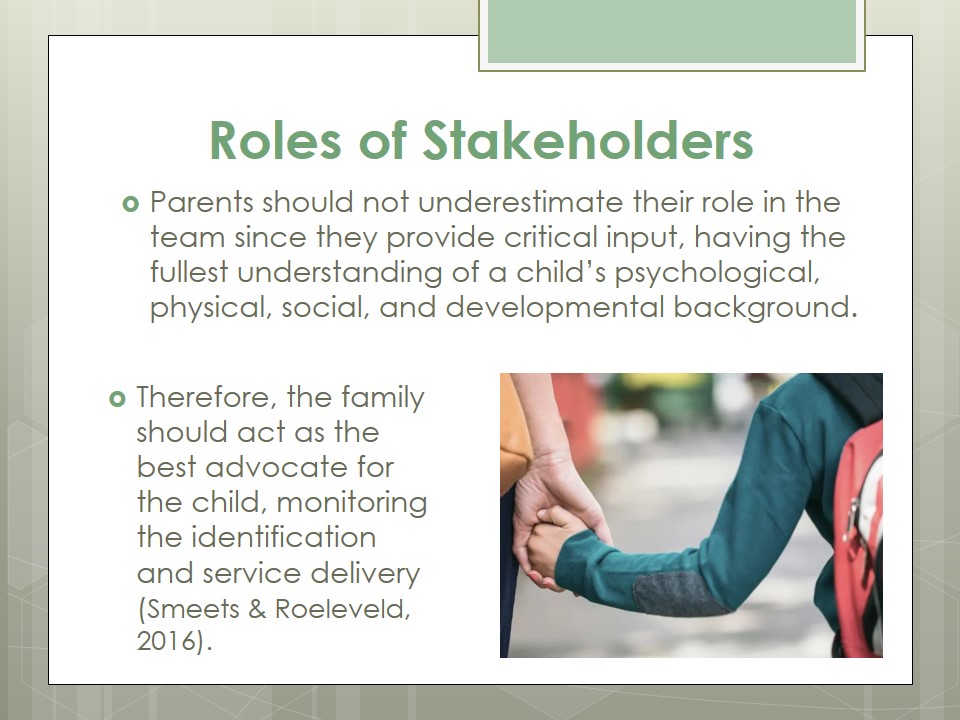
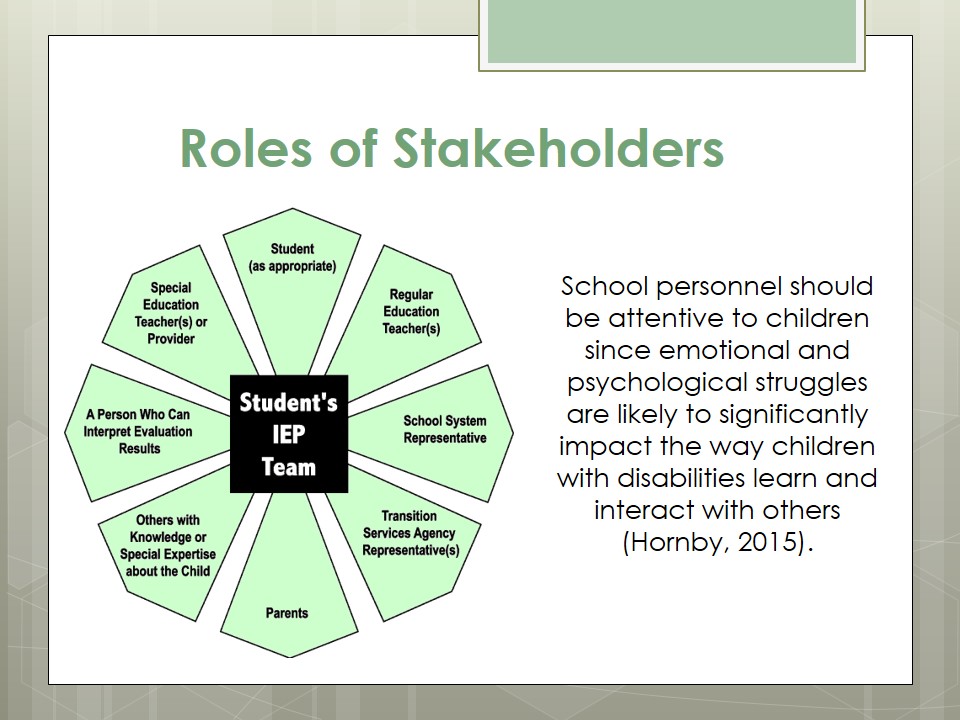
Communication with Families
- To communicate with families, it is possible to meet with them or contact by phone or email, which depends on a certain situation (Hornby, 2015).
- Some parents prefer discussing their child by phone as it creates a sense of intimacy, but this method is prone to misunderstanding.
- Face-to-face communication method serves as the most effective means in the process of special education identification.
- Traveling folders is another option: daily notes, a place for homework, and the communication folder.
Every team member must work towards the same goal of designing the most effective and least restrictive learning environment. The ongoing communication among the stakeholders is regarded as a key mechanism that ensures support for a child and leads to consistent results. It is recommended for the teachers to use emails and phones to share good news or make appointments.
The family can be embarrassed by discovering that their child has disability, others may think that teachers do not understand the value of their child. Regardless of a communication method, teachers should strive to provide the continuity of service delivery and interact with parents on a regular basis, not only in crisis periods.
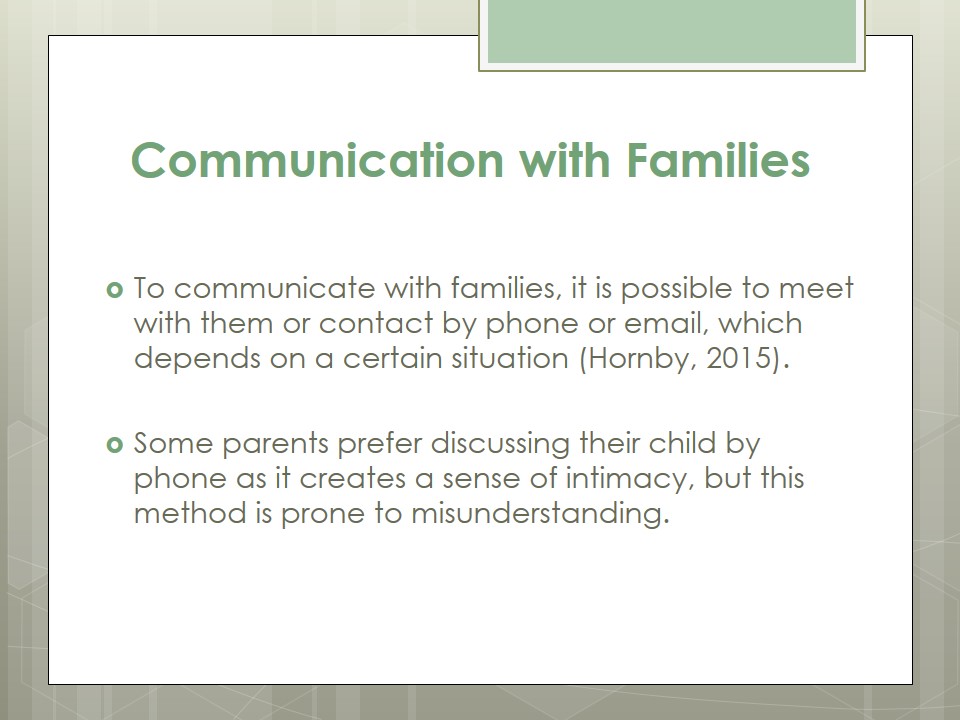
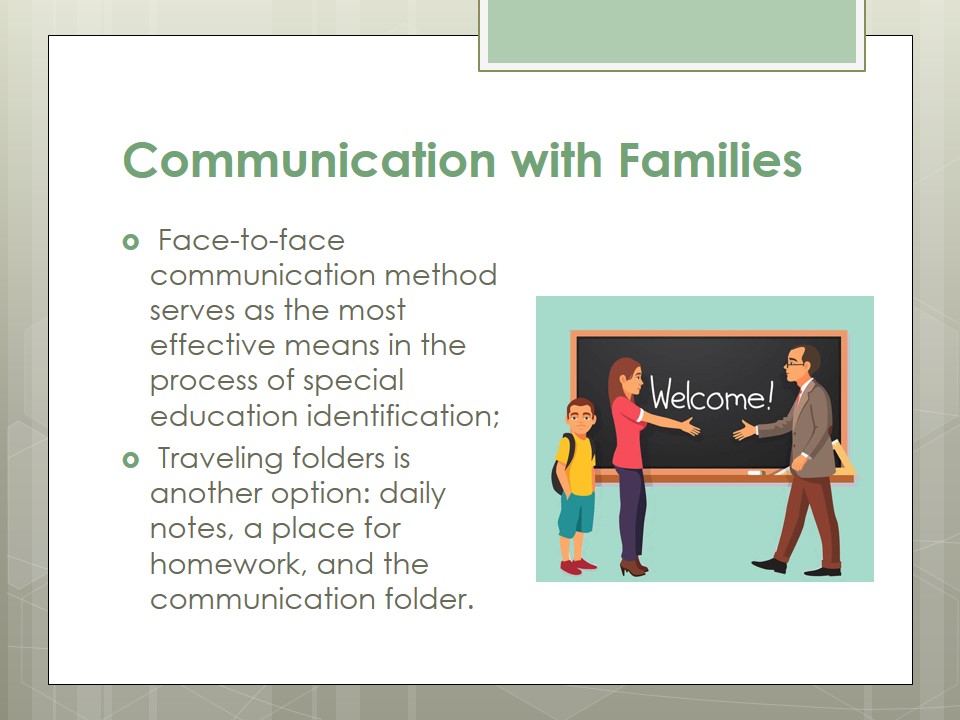
Conclusion
- 504 Plan, IEPs, and IFSPs are launched and monitored by different acts and organizations, but their goal is to ensure that students with disabilities would learn in the least restructure environment.
- To identify, implement, and maintain the programs, not only school personnel but also parents should be engaged in the process of service delivery.
To conclude, the differences between the 504 Plan, IEPs, and IFSPs are associated with the degree to which a student needs support from teachers and parents. These programs are launched and monitored by different acts and organizations, but their goal is to ensure that students with disabilities would learn in the least restructure environment that can meet their specific needs. Proper communication between the team members is the key premise of their effective cooperation.
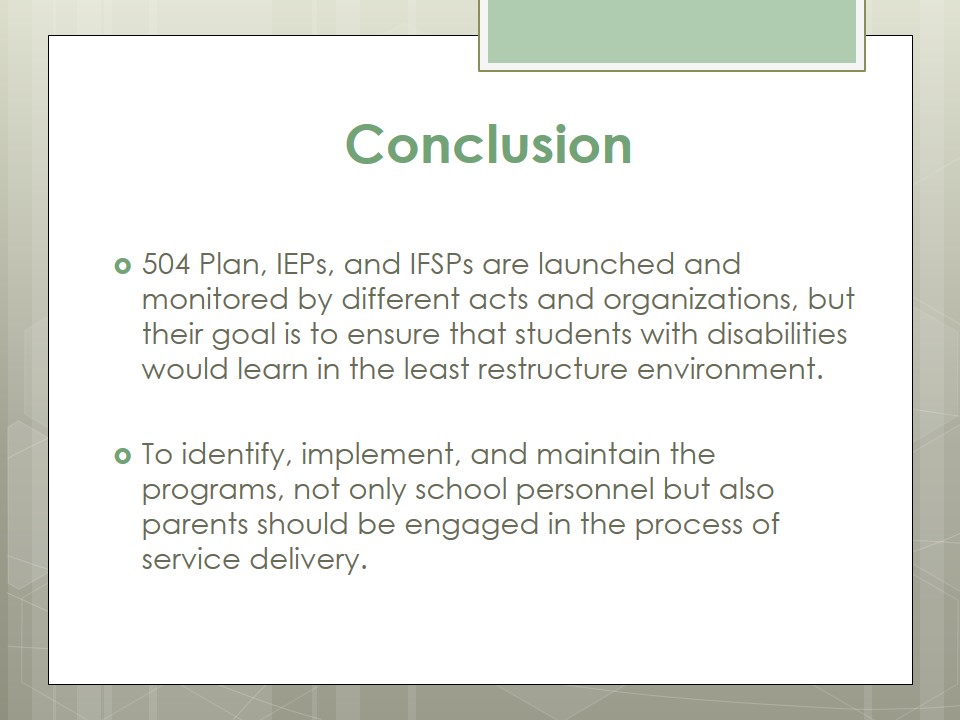
References
Caruana, V. (2015). Accessing the common core standards for students with learning disabilities: Strategies for writing standards-based IEP goals. Preventing School Failure: Alternative Education for Children and Youth, 59(4), 237-243.
Hornby, G. (2015). Inclusive special education: Development of a new theory for the education of children with special educational needs and disabilities. British Journal of Special Education, 42(3), 234-256.
Kauffman, J. M., Hallahan, D. P., Pullen, P. C., & Badar, J. (2018). Special education: What it is and why we need it (2nd ed.). New York, NY: Routledge.
Smeets, E., & Roeleveld, J. (2016). The identification by teachers of special educational needs in primary school pupils and factors associated with referral to special education. European Journal of Special Needs Education, 31(4), 423-439.
Wilmshurst, L., & Brue, A. W. (2018). The complete guide to special education: Expert advice on evaluations, IEPs, and helping kids succeed (3rd ed.). New York, NY: Routledge.
Woodworth, J. (2016). IEPS, 504 plans and behavior contracts. Web.